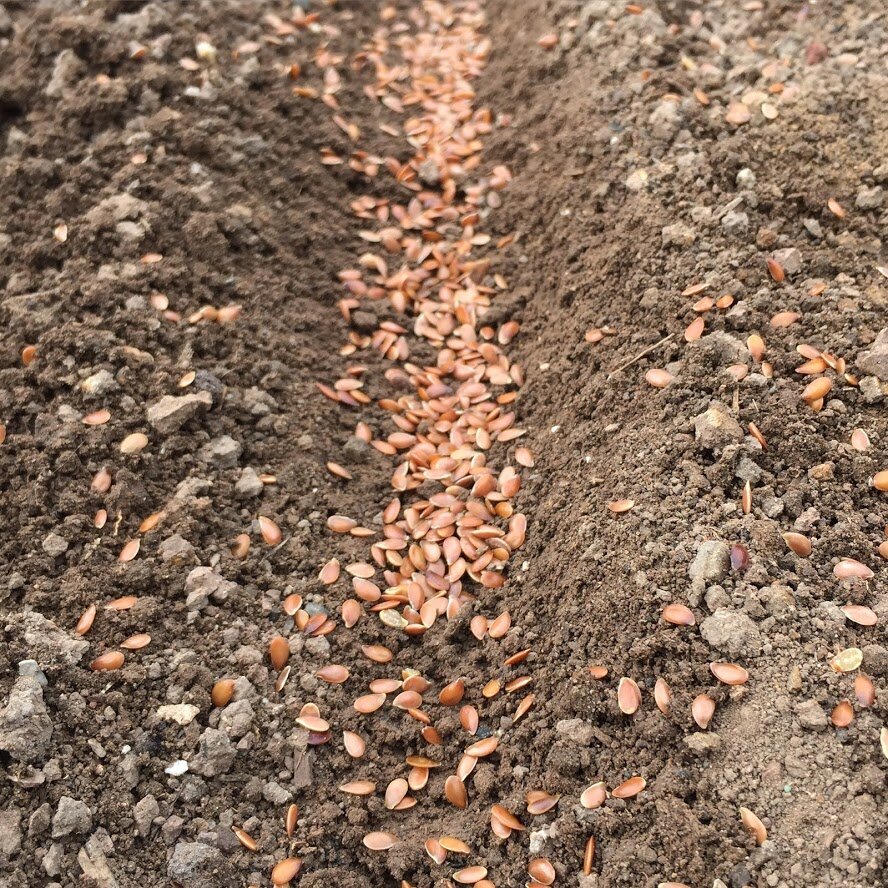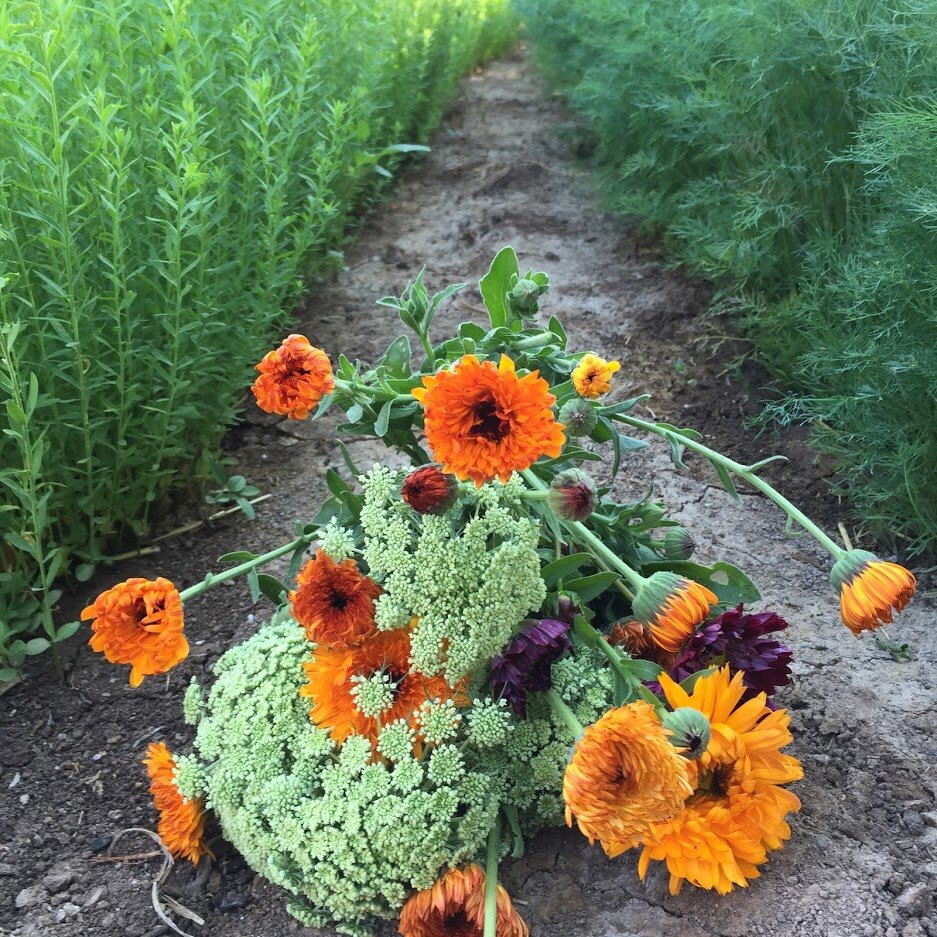Direct Sowing for the Flower Farmer
So we’ve talked a lot about seed starting and seed starting in particular in either cell trays, flats or soil blocks.
What we haven’t talked about of course is direct sowing into the field. Now direct sowing is great because it allows for you to really cut down on your time as a flower farmer, skipping over babying seed in cell trays, growing out the seedlings, and then transplanting the seedlings which takes a lot of time especially in April and May for us - the busiest times of the year.
Direct sowing flax seed (Linum usitatissimum)
What is Direct Sowing?
By direct sowing certain flowers, it really makes your life easier. You just plant your seeds in the ground, keep the bed weeded and watered, and before you know it you have plants growing - it’s so easy in comparison to having to seed transplants.
In fact, this is how most large scale farmers seed their crops - directly sowing their seeds and drilling them into the ground (using large and expensive machines of course) - and what we’ll be accomplishing albeit on a smaller scale and with less moving parts.
Note that there are correct times to sow certain crops. Late fall is best for getting certain hardy annuals like ammi and larkspur and bells of Ireland established (while the ground is still warm from the summer but air temperatures are getting cooler and the days are shorter) while late spring/early summer is best for certain tender annuals like basil, zinnias and broomcorn that need warm soil to germinate quickly and fully.
Direct sown calendula, cosmos, daucus (with flax and dill on either side) - makes for an easy and great early-summer bouquet!
Advantages of direct sowing
Saves a lot of time and effort
Not going to lie, direct sowing seeds is the easiest and most fulfilling way of starting plants. You just plant your seeds, water and wait for the plants to start growing. When you’re having to painstakingly sow every single seed, protecting and babying it from the environment, potentially having to look after it for months, direct sowing is a much easier option.
Great for large volume crops
There are some crops that we need a lot of in large volumes. Crops like bachelor buttons, annual baby’s breath, basil, dove millet, German millet, broomcorn, branching sunflowers, small zinnias all are some of our staples on our flower farm. They also are some of the most easily direct-sown materials that we can grow, which is great because we need hundreds or thousands of them planted and the idea of planting all those by hand is intimidating. I’m happy that they can be direct sown instead!
Save money on potting mix, trays, heating
Since you’re using the great outdoors as your growing environment, you don’t need much equipment. There are no cell trays, no seed starting trays, no potting mix, no humidity domes, no heating needed. At most you could place some frost cloth or Agribon on top of the seeds to ensure they have a nice little warm microclimate to start germinating, but otherwise you’re leaving the seeds up to mother nature to raise.
No transplantation issues, no hardening off needed
Unlike transplants grown inside, you don’t need to harden off direct sown seedlings. You don’t need to transplant them either, which is even better. I would say that the majority of work for flower farmers in the first half of the year (until July) actually is transplanting and establishing all the plants that will come into harvest during the second half of the year, and for most of us is problematic since it all comes at one time during the months of April and May and June.
Being able to direct sow some crops allows us to focus on crops that require a bit more babying - lisianthus, eucalyptus, dahlias and mums for instance - and is a huge timesaver for us at that time of year.
Disadvantages of direct sowing
But as easy as it sounds, there are disadvantages to direct sowing. While it sounds amazing, the actual reality is that things get a little more complicated.
Easy to waste a lot of seed
Especially with finer seed like poppies or foxgloves it is difficult to spread out the seed evenly. Bigger seeds like sunflowers and zinnias? No problem. But if it is more like a fine dust than it is a pelleted seed, you’re probably better off starting them as plugs or soil blocks to get them at least established as seedlings before planting. Fine seed is very easily blown away, washed away, or buried and it won’t germinate the way you want to.
Especially expensive seed or seed that takes a long time to come up (like many perennials) I don’t recommend sowing the seed willy-nilly into the ground. You’ll never find them again for one, but secondly it is amazingly easy to go through a packet of seed like that very quickly if you’ve got an entire farm to sow into.
Dependent upon the environment
In addition, there are a lot of environmental factors outside that can negatively impact your seeds. Torrential flooding and snow can be an issue, as can predation by insects and animals. There’s also the fact that you don’t control the weather outside like you can inside a greenhouse or a tray - you’re at the mercy of mother nature as far as humidity, temperatures and light.
There is always an element of chaos and entropy with nature when you’re flower farming, but direct seeding may be too risky for some. It may also not work with your schedule - seeds sown late winter may not have the heat or the sunlight to be able to start germinating until spring, which eliminates the advantage of trying to start them early at all.
In addition, the more wet, flood-prone conditions of late winter and spring may end up burying or drowning your seeds as well. You have to understand the conditions of your environment to see if direct sowing is a good option for you.
Weed competition
While your seeds can start growing very well, so too can the weeds. Chances are that if your seeds are happy and are starting to grow, so are the weeds. And the weeds always will overtake the desired plants or at least cause a disturbance, and will need to be removed at some point.
In some cases, weeds can grow very quickly and vigorously to the point where you can actually lose your seedlings among the weeds. If you live in a location where weed competition is really severe, you may want to opt for plugs instead simply because your direct-sown seedlings may not stand a chance against the weeds.
Direct sown Dove Millet - tall, healthy, and with no effort on my part!
Best Annuals for Direct Sowing
So what seeds do we direct sow?
As I mentioned previously, it’s mostly annuals that we direct sow. Their quick growth and short season means they’re prime candidates for direct sowing - both hardy annuals and tender annuals.
A good bet for annuals that will direct sow well is if they self-sow on your property. Some would argue that certain plants seem to do best when direct sown - larkspur for instance, once you grow once on your property will continue to reseed and grow everywhere with little effort on your part.
Hardy annuals
Cress
Larkspur
Shirley and Corn poppies
Bachelor buttons
Nigella
Edible peas
Nasturtiums
Dill
Fennel
Ammi majus and Ammi visnaga
Daucus
Calendulas
Tender annuals
Amaranthus
Basil
Cosmos
Marigolds
Zinnias
Sunflowers
Seed-grown dahlias
Ornamental grasses like dove millet and german millet
Broomcorn
Celosia
Gomphrena
Ensuring success with direct sowing annuals
1) You’ll want to ensure your seedbed is free of rocks and branches and any debris that could make it hard to seed into. Rake and smooth your bed to a fine tilth.
2) We also like to ensure that it is as weed-free as possible. You can pre-germinate your bed by watering it and putting some frost cloth over it to heat it up and then getting rid of the weed seeds that pop up. Or if you’re using black landscape fabric, that can also help to suppress weeds. There will inevitably be some weed seeds that will find their way in, but these can be easily be pulled - you just don’t want an existing stand of weeds or masses of weed seeds that will make your life more difficult in the future. .
3) When sowing our seeds, we will dig a very narrow and shallow trench, about 1” deep and sprinkle the seed into that (or alternatively, we’ll lay down a wooden board or stick and sow seeds individually into the ground if they are easier to handle like zinnia, sunflower and pea seeds). We’ll water the seeds in gently with a watering wand and then cover with frost cloth in the cooler months - which helps to keep moisture in, prevent birds and animals from eating seeds and seedlings, and also adds a bit of warmth to the soil to encourage germination (we’ll leave the frost cloth on for a week or two while the seeds sprout)
4) Make sure you keep the area well watered and moist to encourage good seed germination. (Alternatively if you live where it is wet and rainy, you may want to instead put up some plastic to keep the area dryer to prevent your seeds from getting waterlogged). After the seeds start germinating and get their true leaves, we’ll go back through and remove the frost cloth and then weed out any weed seedlings that have popped up. You can also thin seedlings, but we rarely do that because we really like to cram our plants together for the maximum amount of flowers possible.
5) After that, you just take care of the baby seedlings the way you would with transplants - regular watering, fertilizing and then netting and pinching all the way through harvest!
I hope this inspires you to start direct sowing
Even if it’s not for every single crop you grow, there are a lot of crops that do very well with direct sowing and will make your life a lot easier - especially during the more busy times of the year, which can lead to a better work-life balance and a happier flower farmer!
What crops do you direct sow?



